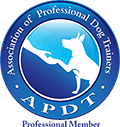Archive CF :: Establishing Communication in the Human/Canine Family
Training is a crucial element in establishing communication and mutual respect, while also strengthening the bond, in the inter-species family of humans and dogs. Our greater awareness of what our dogs are telling us, as well as what they are reading in our behavior -- in other words, people reading their dogs and dogs reading their people more accurately -- will make this journey a far easier and more profound one.
Dogs, as descendants of wolves, are highly social pack animals who communicate through body language, and, having evolved living so closely with humans, dogs have become very successful at reading human facial and body language. This means that training that starts with physical signals or cues and then attaches verbal commands later will facilitate learning.
Because dogs have become such intimate family members, we humans often confer greater commonality than is helpful. Presumptions about dogs' emotional lives have been a divisive component to human-canine understanding. While dogs are highly intuitive and smart, they do not understand complex concepts such as guilt or retribution. Thus, granting such complex emotional comprehension to dogs only hinders our ability to truly understand them. One common misinterpretation arises when a dog breaks housetraining practices. So often their submissive behavior is interpreted as guilt when it is more likely that the dog has been reprimanded in the past and is preemptively offering submissive, conciliatory signals, called appeasement gestures.
Establishing Family Hierarchy
Much attention has been paid of late to the notion of the human component in the inter-species family establishing themselves as alpha to the family's canine component. There is no dispute that the human as leader is an essential hierarchical relationship. But the more pertinent and essential question is what type of leader should he or she be, a dominating one, as some popular voices in the industry would suggest, or a benevolent one?
Human leadership can be effectively, and safely, established through training protocols, involving polite behaviors (sit, down, come, wait, etc) in order to gain access to desirable things like food or water, a game of tug, a walk outside, or even some loving. Simply put, training is not for the sake of establishing obedience in our canine family members but rather establishing a relationship with them that is based on mutual respect.
Finding a Common Language
By teaching our dogs how to exhibit polite behaviors when interacting with people, we are communicating our expectations of how they should behave. Additionally, by understanding how dogs communicate with each other, we can more effectively construct a relationship that is mutually respectful and beneficial.
Introductions
A typical human greeting is face-to-face, with locked eye contact, as we lean engagingly forward and grasp hands. But what is an engaging stance to another human can be construed as highly challenging, particularly to a shy dog. Polite dogs approach in an arc, the more submissive averting her gaze, for a polite sniff of introduction. A human equivalent of this might be to allow a shy dog to make the approach, averting your eyes and offering a hand to sniff, and then, if the dog has accepted your polite invitation for an interaction, petting under the chin rather than over the head.
Conversely, the genital sniff is like a doggie handshake, but it's not something that humans welcome. Nor is the jumping of an exuberant greeter. Teaching your dog a polite greeting ritual, such as sitting while people approach, will communicate your expectations and equip your dog with an acceptable alternative.
Understanding Distance-Increasing Signals
One of the greatest myths about dog body language is that a wagging tail is equivalent to a welcoming invitation. While tail position is very individual and depends largely on breed, some generalizations can be made: A loose, full-sweeping wag is a harbinger of friendly tidings, but a tight, fast, high wag is more often a distance-increasing signal, a warning off. Distance-increasing signals that are more familiar to us are growling or the showing of teeth, but there are other more subtle signals, like freezing or stillness or the show of eye whites, called whale eye.
Distance-increasing signals should be respected and, most importantly, not punished; punishing a growl leaves a dog with only the vocabulary of biting to indicate discomfort. Rather, discover the root of your dog's discomfort and try to change his feelings about that stimulus.
Recognizing Stress Signals
Often dogs communicate their stress by performing behaviors out-of-context. Such indicators might be a dog's lip licking, yawning, scratching, sniffing, or shaking off. These are behaviors that are a typical part of a dog's array of behaviors but, when set in an unusual context, they may indicate stress or discomfort. For instance, you may notice that, as a dog approaches your dog, your dog suddenly starts to sniff the ground intently. Though sniffing is a natural dog behavior, it's strange in this context. It's unlikely that an irresistible odor suddenly materialized at her feet! This might well indicate that she looks upon this interaction with some trepidation.
As a youngster, my dog Trista used to yawn when I would ask her for a sit at the front door on our way out for a walk. She just wanted to go outside and saw this ritual as a mildly stressful hoop that she had to jump through before taking her much anticipated walk! Though yawns are normal dog behavior, you can see that it is strangely out of context in this situation... an indication of stress.
But not all stress is bad. Stress can actually encourage performance at a higher level. So, though I recognized Trista's yawn for what it was, I nonetheless insisted on her sitting at the front door. And, over time, she learned to take this ritual in stride so that nowadays she sits calmly at the door, secure in the knowledge that she will soon be satisfied with her walk.
So, though some stress is good, it is helpful to recognize it and particularly to recognize its increase. While a single stress signal might not necessarily alarm you, you should very definitely take notice of compound signaling. If, as a child approaches, your dog licks her lips, yawns, and gives whale eye, that is very definitely an interaction that you should prevent!
Using Doglish
Employing techniques that imitate behavior native to dogs can help bridge the gap between human and canine understanding.
- During puppy play, if one puppy bites another puppy too hard, the one bitten will let out a high-pitched squeal and stop playing. The biter will learn good bite inhibition from such interactions. We can use these same techniques to instruct puppies on bite inhibition, letting out a high-pitched "ai!" and removing our hands from play. Many puppies will learn quite quickly that biting humans makes the fun stop. (For those who become more aroused with your squeals, use a time-out.)
- One way dogs dismiss one another is by averting eye contact, their way of saying "Bug off!" Try doing this with your own dog and see the results.
- Jumping up is a dog's rude way of seeking attention; it's an infringement on our personal space. One way to discourage this is by putting your hands up across your chest and turning your back -- a form of dismissal. For the avid jumper, an alternative is to take up the dog's space in return, walking into him as he leaps up on you (do not knee him in the chest -- that's painful!). Often he will back into a sit as a result, a behavior you can reward!
-
Much has been made of the adversarial nature of the game of tug.* In fact, far from being adversarial, tug in its very essence was a cooperative activity to bring down game on a hunt. There is no better illustration of its cooperative nature than watching a game of tug between an adult dog and a puppy. Often the adult will self-handicap, pulling only as hard as the puppy is capable of in order to keep the game going. So tug is a great way to strengthen your bond with your dog by enjoying fun playtime together.
* Dogs who guard their toys are a different story
One of the most striking differences between canis lupus and canis familiaris is the latter's ability to read our facial expressions. As dogs have evolved at the side of humans, they have been attentive students, learning to distinguish the ripple of expressions that pass over our faces with the same fluency that they read their own brethren. With this in mind, make sure not to give your dog mixed signals. If your dog is doing an undesirable behavior, like jumping up or pawing at you, no matter how cute he might seem to you at that moment, don't smile while saying "no". It's like the old saying: "Your words may say no but the rest of you is saying yes, Yes, YES!" Send a consistent message on all frequencies: words, tone of voice, body language, and facial expression.




